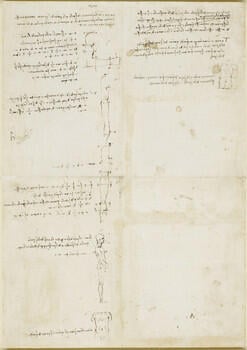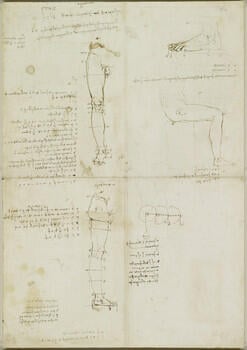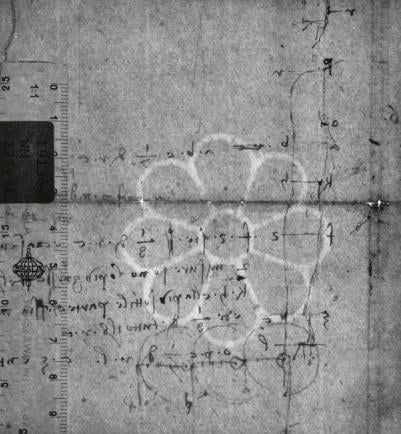-
1 of 253523 objects
Studies of human proportion c.1490
Recto: Pen and ink with some red chalk. Verso: Pen and ink | 40.0 x 28.0 cm (sheet of paper) | RCIN 919136
-
On the recto, notes on proportion; three drawings of right arms, one flexed, two hanging straight; a man standing in profile to the right; back and front views of a male torso. Verso: notes on the proportions of a leg, illustrated by a right leg; notes on the proportions of the foot and the leg; a study of pulleys with notes on dynamics. This drawing was originally folded into four, and so was numbered in the old inventory as four drawings, RL 19136 - 19139.
The drawing belongs to a series of sheets that form Leonardo’s earliest and most sustained study of human proportion. All the drawings in this series are executed schematically in pen and ink with no underdrawing and are neatly laid out on the page, suggesting that Leonardo was making a ‘fair copy’ of rough notes compiled elsewhere. But the simplicity of the Vitruvian precepts seen on RCIN 919132 was undermined when Leonardo here began to measure a model, named on this sheet as an individual named as ‘Caravaggio’ and so from that town near Milan - perhaps the painter Andrea da Caravaggio.
On the verso of the sheet Leonardo recorded the thickness of his leg at various points, in terms of quarters, fifths, twelfths, and even seventeenths of a head - an early example of overwhelming detail in Leonardo’s scientific investigations. For example, the notes beside the leg seen from the front read:
ac is half a head, and is the same as db, and to the attachment of the five toes ef.
dk diminishes a sixth in the leg at gh.
gh is one-third of a head.
mn increases by one-sixth from ac and is seven-twelfths of a head.
op is one-tenth less than dk and is six-seventeenths of a head.
a is in the middle between q and b and is one-quarter of a man.
r is in the middle between s and b.
The hollow on the outside of the knee at r is higher than the hollow on the inside at a by half the thickness of the leg at the foot.
And so on. However the study of a pulley to lower right is accompanied by a note on simple mechanics:
Five men against one thousand pounds in one hour; one man in five hours; a fifth of the force of one man in twenty-five hours. And in this way it always goes, he who lightens the work prolongs the time.
Although the sheet is ostensibly concerned with external anatomy, Leonardo has in the drawing at upper left indicated some detail of the knee joint, and in the other two principal studies, loose scribbles represent the position of the greater trochanter at the head of the femur. The drawings of a standing leg demonstrate the importance of aligning the parts when depicting stance.
Text adapted from M. Clayton and R. Philo, Leonardo da Vinci: Anatomist, 2012, no. 16Provenance
Bequeathed to Francesco Melzi; from whose heirs purchased by Pompeo Leoni, c.1582-90; Thomas Howard, 14th Earl of Arundel, by 1630; probably acquired by Charles II; Royal Collection by 1690
-
Creator(s)
Acquirer(s)
-
Medium and techniques
Recto: Pen and ink with some red chalk. Verso: Pen and ink
Measurements
40.0 x 28.0 cm (sheet of paper)
Markings
watermark: Flower (large, 8 petals, thick outline) [-, Codex Arundel 112/115]
Object type(s)
Other number(s)
RL 19137RL 19138RL 19139


